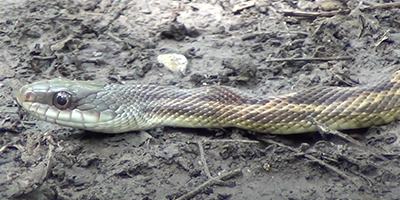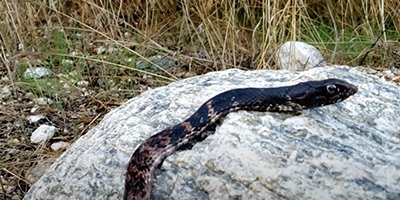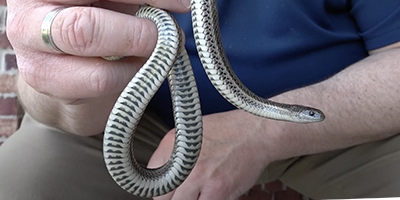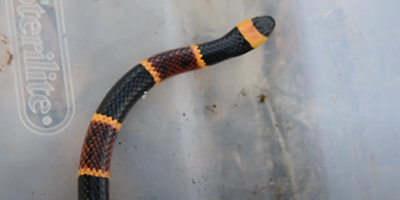
Welcome to corpuschristisnakes.com! I am David, a snake enthusiast living in Corpus Christi, TX. Many people don't know that Corpus Christi is in fact full of snakes! You just need to know where to find them - they can often be shy and elusive. Some Texas snake species are more common outside of the city limits, in different parts of Nueces County TX, but many types of snakes are indeed common in the more urban parts of Corpus Christi. This guide is meant to help educate you about the beautiful snakes of Corpus Christi, and to help you identify the most common snakes of Corpus Christi, as well as the venomous snakes of Corpus Christi that you should learn to recognize and avoid. If you want more detail, click here for my complete list of ALL snake species in Corpus Christi. Remember the following:
- Most snakes of Corpus Christi are harmless and don't want to encounter you
- Venomous snakes exist but are uncommon in Corpus Christi, Texas
- Snakes eat rats and mice and are a valuable part of the Texas ecosystem
- Never kill a snake - if you leave a snake alone, it will leave you alone.
Common Snake Species in Corpus Christi
 Texas Rat Snake:
Considered a subspecies of the black rat snake, Texas rat snakes (Elaphe obsoleta linheimeri) are primarily found in Texas. Their coloring can vary significantly, but generally, they are tan in color with dark blotching from head to tail. As a rule of thumb, the further north you go, the darker they become.
In length, they can reach 4 to 5 feet. But despite their large size, they have a timid nature. However, if approached or threatened, they will respond. Mostly they will release a foul-smelling musk if picked up, typically used to ward off predators.
In the wild, they eat anything from rodents to birds and even lizards and insects. Generally speaking, they pose no threat to humans.
Texas Rat Snake:
Considered a subspecies of the black rat snake, Texas rat snakes (Elaphe obsoleta linheimeri) are primarily found in Texas. Their coloring can vary significantly, but generally, they are tan in color with dark blotching from head to tail. As a rule of thumb, the further north you go, the darker they become.
In length, they can reach 4 to 5 feet. But despite their large size, they have a timid nature. However, if approached or threatened, they will respond. Mostly they will release a foul-smelling musk if picked up, typically used to ward off predators.
In the wild, they eat anything from rodents to birds and even lizards and insects. Generally speaking, they pose no threat to humans.
 Western Coachwhip:
The western coachwhip (Masticophis flagellum), often known only as the coachwhip, derives its name from its slender appearance. In particular, its slight tail. In color, they range from brown to tan or yellow. However, some sub-species are known to be pink.
You’ll find coachwhips in open fields and pine forests. There they eat lizards, birds, and rodents: subduing their prey with a firm bite. These bites are painful but not harmful. Therefore, they are little threat to humans.
Western Coachwhip:
The western coachwhip (Masticophis flagellum), often known only as the coachwhip, derives its name from its slender appearance. In particular, its slight tail. In color, they range from brown to tan or yellow. However, some sub-species are known to be pink.
You’ll find coachwhips in open fields and pine forests. There they eat lizards, birds, and rodents: subduing their prey with a firm bite. These bites are painful but not harmful. Therefore, they are little threat to humans.
 Lined Snake:
Endemic throughout the central United States, the lined snake (Tropidoclonion lineatum) is a common non-venomous snake. Often confused with garter snakes, they have characteristic tan and yellow stripes running the length of their bodies. However, unlike garter snakes, they are typically smaller, growing to between 8 to 12 inches in length.
They are found in grasslands and oak savannahs. But are not exempt from suburban areas. Generally, like coral snakes, they are fossorial. As such, their main diet is earthworms.
Lined Snake:
Endemic throughout the central United States, the lined snake (Tropidoclonion lineatum) is a common non-venomous snake. Often confused with garter snakes, they have characteristic tan and yellow stripes running the length of their bodies. However, unlike garter snakes, they are typically smaller, growing to between 8 to 12 inches in length.
They are found in grasslands and oak savannahs. But are not exempt from suburban areas. Generally, like coral snakes, they are fossorial. As such, their main diet is earthworms.
Venomous Snake Species in Corpus Christi
 Copperhead:
Copperheads (Agkistrodon contortrix) are a formidable and ferocious snake that’s best avoided. They’re highly likely to bite if approached; however, their venom isn’t particularly potent. Its name stems from its orange-brown coloring, which is most noticeable at the head. Their body is banded with dark stripes.
Found throughout the continental US, there are multiple sub-species. But generally, copperheads are solitary hunters. They are ambush predators who wait for prey to pass by. Then they strike and follow the scent trail to where the prey has died from the venom.
Copperhead:
Copperheads (Agkistrodon contortrix) are a formidable and ferocious snake that’s best avoided. They’re highly likely to bite if approached; however, their venom isn’t particularly potent. Its name stems from its orange-brown coloring, which is most noticeable at the head. Their body is banded with dark stripes.
Found throughout the continental US, there are multiple sub-species. But generally, copperheads are solitary hunters. They are ambush predators who wait for prey to pass by. Then they strike and follow the scent trail to where the prey has died from the venom.
 Coral Snakes:
Coral snakes (Elapidae) are often mistakenly identified as scarlet kingsnakes. However, this is a potentially deadly error, as coral snakes can deliver a potent, and fatal, neurotoxic venom. As a rule, if red and yellow bands are together, then it is a coral snake. But there are exceptions. Most coral snakes don’t grow greater than 3 ft. in length, although there are reports up to 5 ft.
Fortunately, coral snakes are fossorial: meaning they prefer to burrow, residing beneath the leaf litter or underground. There they feed on small snakes, lizards, ground-nesting birds, and small mammals. However, due to their small fangs, they don’t bite and release. Instead, gripping their prey till the venom has taken effect.
Coral Snakes:
Coral snakes (Elapidae) are often mistakenly identified as scarlet kingsnakes. However, this is a potentially deadly error, as coral snakes can deliver a potent, and fatal, neurotoxic venom. As a rule, if red and yellow bands are together, then it is a coral snake. But there are exceptions. Most coral snakes don’t grow greater than 3 ft. in length, although there are reports up to 5 ft.
Fortunately, coral snakes are fossorial: meaning they prefer to burrow, residing beneath the leaf litter or underground. There they feed on small snakes, lizards, ground-nesting birds, and small mammals. However, due to their small fangs, they don’t bite and release. Instead, gripping their prey till the venom has taken effect.
 Pygmy Rattlesnake:
One of the many pit vipers in the US, pygmy rattlesnakes (Sistrurus miliarius) aren’t as ferocious as their western cousins. However, they are more common along the coasts, and their venom is still unpleasant, albeit not particularly dangerous.
They are often seen in the summer sun or crossing roads. As their name suggests, they remain small, mostly growing no longer than 24 inches. Due to their small size, their diet is similarly tiny: small rodents, frogs, lizards, and insects. They’ll also go after giant desert centipedes.
Despite being small and non-deadly, their bite can still leave children hospitalized. Therefore, be careful, if spotted.
Pygmy Rattlesnake:
One of the many pit vipers in the US, pygmy rattlesnakes (Sistrurus miliarius) aren’t as ferocious as their western cousins. However, they are more common along the coasts, and their venom is still unpleasant, albeit not particularly dangerous.
They are often seen in the summer sun or crossing roads. As their name suggests, they remain small, mostly growing no longer than 24 inches. Due to their small size, their diet is similarly tiny: small rodents, frogs, lizards, and insects. They’ll also go after giant desert centipedes.
Despite being small and non-deadly, their bite can still leave children hospitalized. Therefore, be careful, if spotted.
If you're unsure, you can email me a photo of the snake at info@corpuschristisnakes.com and I will email you back with the snake's species. If you found a snake skin, read my Found a Skin? page, and you can email me a photo of the skin, and I'll identify the snake for you. If you need professional Corpus Christi snake removal help, click my Get Help page, or see the below website sponsor I found, who provides that service.
Understanding The Banded Water Snake: Appearance, Biology, Life Cycle, Habitat, Diet, Behavior
About the Banded Water Snake
Harmless, the banded water snake may be mistaken for a more harmful and dangerous snake – the cottonmouth snake. Even so, the banded water snake is not one to fear. They are a non-venomous type of snake that prefers to stick around water, away from humans. They will stay on the water’s edge, or directly in water, instead of living or going where most humans are. From hunting to relaxing, you are more likely to find them going off on their own and stay away from people and predators than standing their ground. As a nonvenomous snake, that is a common trait for them to have.
Appearance
The banded water snake does not get that large. Most only grow to about a few feet, and are not that wide or heavy. The head of these snakes may get somewhat wide, but the snake itself remains small. The coloring is usually red or brown, with darker colored bands running down its body. The bands are not that strong in appearance, however, so you most just see the color itself.
Life
Mating season the banded water snake starts in summer to early autumn. They will spend this time mating, attempting to have young. If successful, the female will give birth to live young just a few months later.
Behavior
Banded water snakes do not want to be near humans, nor do they want to be handled, unless raised around humans. In a normal situation, the snake is likely to run away from any perceived threat, including humans. They are fearful and would rather go somewhere safe, for the sake of self-preservation. They can emit an odor and bite if they feel there is a threat to them, but that is a last resort situation.
Habitat
As an aquatic snake, the banded water snake does prefer to live around water. It will live near any type of body of water that offer protection and food readily. Any time there is an issue with the local environment, they may move to another area that offers better availability of food and shelter.
Diet
Like other aquatic snakes, they primarily eat fish, frogs, and whatever small rodents may come their way. They will hunt in and around water, so whatever is there is their main source of food. There is no reason to fear the banded water snake. These are harmless snakes that pose no risk to you or others and would prefer to stay on their own.
Remember, the term is not poisonous snakes of Corpus Christi, it's venomous snakes of Corpus Christi. Poison is generally something you eat, and venom is injected into you. That said, dangerous snakes are very rare in Corpus Christi. The few venomous snakes of Nueces County are rarely seen. But they are commonly misidentified, so learn about all the snake species of Corpus Christi in order to correctly identify them. These snakes are usually also found in the surrounding towns of Port Aransas, Robstown, Bishop, Agua Dulce, Banquete, Driscoll, Petronila, Tierra Grande, North San Pedro, La Paloma-Lost Creek, Sandy Hollow-Escondidas, Tierra Verde, Rancho Banquete and the surrounding areas.
Read our article about:
Will Mothballs Or Ammonia Help To Keep Snakes Away?
corpuschristisnakes.com domain and hosting costs made possible by the generous support of this sponsor:
